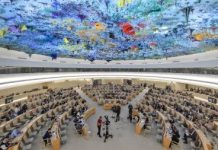Huma Arshad
After successfully defeating COVID -19, the top leadership of China recently revealed the plans and strategies for making China a modern socialist world power in all important fields, like technology, economy, and other fields by 2035. Long-range objectives of vision 2035 were laid down in the 5th plenary session of the 19th Central Committee of CPC. The 19th Central Committee of the Chinese Communist Party was elected by the National Congress in 2017 and will remain there till the next National Congress is summoned in 2022. The geopolitical relation of US-China will be the main focus of China’s Vision 2035. By 2035 China aimed to double its GDP up to 100 trillion Yuan and double the current per capita GDP of $10,000 which means 3.5 percent GDP growth annually.
Sinocentrism refers to the ideology that China is the cultural, political, and economic center of the world. China includes Sinocentric ‘World Dream’ in Vision 2035 that is from China’s dream to the world dream. The whole Vision 2035 revolves around this ideology.
Taking major steps in core technologies, by 2035 China will become a global leader in innovation. China will finish building a modernized economy. The per capita GDP will reach the level of moderately developed countries. Eco-friendly ways of work and life will be advanced to cover all areas of society. Carbon emission will steadily decline after reaching a peak. The implementation of the secure China initiative will be enhanced to taken levels. China aims to encourage a combination of an efficient market and an effective government.
Why the year 2035?
The question is why 2035? The reason is it is halfway between the centenary of the founding of the Communist Party of China (CPC) and 249’s 100 anniversary of the founding of new China. The main aim is to achieve socialist modernization and new dimensions of China’s relations with the world. China has already started working on aligning its domestic development with its international relations. Examples of this are China’s Belt and Road initiative and the Asian Infrastructure Investment Bank and multilateral trading arrangements like Regional Comprehensive Economic Partnership or China – Pakistan Economic Corridor shows China’s quest towards a new economic paradigm. China has also initiated many reforms to enable sustainable and inclusive developments. These reforms will be beneficial for Chinese consumers, small and medium-sized businesses, and China’s global network of suppliers.
Commitment to an eco-friendly way of life
According to World Bank data, GDP per capita in China is currently at $10,200. By 2035, China intends to both modernize and strengthen its military capabilities. The CPC is also committed to majorly strengthening multilateralism and global governance. Xi Jinping has made a historic announcement in September 2020 at the UN General Assembly related to China’s Commitment to an eco-friendly way of life in “Beautiful China” with peaking emissions in 2030 and steady declines thereafter and carbon neutrality by 2060.“Understanding what China and the CPC have experienced during the past 100 years is crucial to comprehending both China and the world’s future on everything from the world economy to the climate crisis to international relations. Basically achieving socialist modernization by 2035 will be a watershed moment in China’s history.” ( China Focus – John Taylor )











